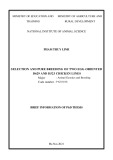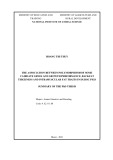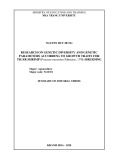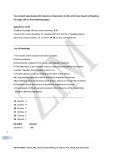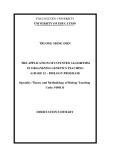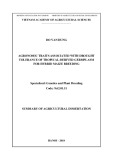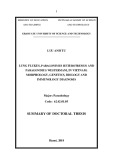doi:10.1046/j.1432-1033.2002.03142.x
Eur. J. Biochem. 269, 4476–4483 (2002) (cid:1) FEBS 2002
Inhibition of human MDA-MB-231 breast cancer cell invasion by matrix metalloproteinase 3 involves degradation of plasminogen
Antonietta R. Farina1, Antonella Tacconelli1, Lucia Cappabianca1, Alberto Gulino2 and Andrew R. Mackay1 1Section of Molecular Pathology, Department of Experimental Medicine, University of L’Aquila, Italy; 2Department of Experimental Medicine and Pathology, University of Rome ‘La Sapienza’, Italy
t-PA and cell membrane-mediated plasminogen activation and impair laminin degradation by plasmin. Our data pro- vide evidence that MMP-3 can inhibit breast tumour cell invasion in vitro by a mechanism involving plasminogen degradation to fragments that limit plasminogen activation and the degradation of laminin. This supports the hypothesis that MMP-3, under certain conditions, may protect against tumour invasion, which would help to explain why MMP-3 expression, associated with benign and early stage breast tumours, is frequently lost in advanced stage, aggressive, breast disease.
invasion; laminin; matrix Keywords: angiostatin-like; metalloproteinase-3; plasminogen.
Matrix metalloproteinase (MMP)-3 inhibited human MDA-MB-231 breast cancer cell invasion through recon- stituted basement membrane in vitro. Inhibition of invasion was dependent upon plasminogen and MMP-3 activation, was impaired by the peptide MMP-3 inhibitor Ac-Arg-Cys- Gly-Val-Pro-Asp-NH2 and was associated with: rapid MMP-3-mediated plasminogen degradation to microplas- minogen and angiostatin-like fragments; the removal of single-chain urokinase plasminogen activator from MDA- MB-231 cell membranes; impaired membrane plasminogen association; reduced rate of tissue plasminogen activator (t-PA) and membrane-mediated plasminogen activation; and reduced laminin-degrading capacity. Purified human plasminogen lysine binding site-1 (kringles 1–3) exhibited a similar capacity to inhibit MDA-MB-231 invasion, impair
resulting in further amplification of BM degradation [17–21]. Amongst the MMP family, MMP-3 (stromelysin-1) is considered pivotal to the integration of plasmin and MMP systems, as it is highly sensitive to activation by plasmin and activates several MMPs. In addition, MMP-3 exhibits substrate specificity for BM components and has been implicated directly in both tumorigenesis and tumour invasion in vivo [19,22–24].
The transition from carcinoma in situ to invasive adeno- carcinoma of the breast is a relevant index of malignant behaviour and is characterized by loss and fragmentation of the ductal basement membrane (BM) [1,2]. Invasive breast tumour behaviour is associated with matrix-degra- ding enzyme over-expression, considered to be responsible for the promotion of the proteolytic environment required for destabilization and fragmentation of the ductal BM [3–9]. The invasive process has been effectively modelled in vitro using a reconstituted BM matrix prepared from mouse Engelbreath-Holm-Schwarm (EHS) sarcoma [10–16].
A general concept is that a proteolytic cascade involving matrix metalloproteinases (MMPs) and the plasmin system degrades BM structures as a prerequisite for tumour cell invasion [17–19]. Plasmin activated from plasminogen by urokinase and tissue type plasminogen activators (uPA and t-PA, respectively) amplified at the tumour cell or matrix surface, degrades BM components and activates MMPs
Correspondence to A. R. Mackay, Section of Molecular Pathology, Department of Experimental Medicine, University of L’Aquila, 67100, L’Aquila, Italy. Fax: +39 862 433523, Tel.: +39 862 433542, E-mail: mackay@univaq.it Abbreviations: BM, basement membrane; t-PA, tissue-type plasmi- nogen activator; scuPA, single-chain urokinase plasminogen activator; tcuPA, two-chain urokinase; MMP, matrix metalloproteinase; APMA, amino-phenyl-mercuric acetate; EHS, Engelbreth- Holm-Schwarm; PBL1, plasminogen lysine binding site-1; EMEM, minimal essential medium with Earl’s salts. (Received 6 June 2002, accepted 25 July 2002)
Recently, however, there has been a change in opinion about the potential roles played by MMPs in tumour progression [25]. This has followed observations that patterns of MMP over-expression do not always predict aggressive tumour behaviour in either human [19,26,27] or animal tumours [28], that enhanced expression of the MMP inhibitors TIMP-1 and TIMP-2 frequently associates with poor outcome or tumour recurrence [29,30] and that MMPs can degrade components of the plasmin generating system and produce angiostatin, suggesting potential roles for MMPs in the regulation of cellular fibrinolytic activity and in the down-regulation of tumour-associated angiogenesis [31–38].
Human breast tumours exhibit some of these anomalies. MMP-3 is expressed by benign and low stage tumours but its expression is frequently lost in association with aggres- sive, advanced stage, disease [26,27]. TIMP-1 and TIMP-2 over-expression associates with malignant breast tumour behaviour in vivo [29,30]. Although MMP-3 expression by benign breast tumours is consistent with a potential role in tumorigenesis [23], the loss of its expression associated with progressive disease raises an important question concerning its role in breast tumour progression. In the present study, we address this point by assessing the role of MMP-3 in an established model of malignant human MDA-MB-231
MMP-3 inhibits MDA-MB-231 invasion (Eur. J. Biochem. 269) 4477
(cid:1) FEBS 2002
inhibitor activities were visualized by staining with Coo- massie blue in a mixture of methanol : acetic acid : water (4/1/5, v/v/v) and destaining in the same mixture without Coomassie blue. breast cancer cell invasion in vitro [10–16]. We report that conditions exist under which MMP-3 inhibits breast tumour cell BM invasive capacity in vitro and we discuss the potential mechanism involved.
Western blots
M A T E R I A L S A N D M E T H O D S
Cells and reagents
and recombinant
Samples, separated by SDS/PAGE under reducing and nonreducing conditions were electrophoretically transferred to nitrocellulose (Hybond C-extra, Amersham Interna- tional). Nonspecific protein binding sites were blocked by a solution of 5% nonfat dried milk in NaCl/Pi. Membranes were incubated with primary antibody diluted in blocking solution and with horse radish peroxidase conjugated secondary antibody diluted in blocking solution (Bio-Rad). Antigen reactivity was demonstrated by chemiluminescence reaction (Amersham International). Immunoreactive bands were visualized on XAR-5 film (Kodak). Molecular weights were approximated by comparison to prestained molecular weight markers (Bio-Rad) using Molecular AnalystTM/PC for the Bio-Rad Model GS-670 Imaging Densitometer. Specificity of antibodies was assessed using preimmune IgG preparations.
Purification of plasma membranes
Human MDA-MB-231 breast carcinoma cells were obtained from the American Tissue Culture Collection and grown in ATCC recommended media supplemented with 10% foetal calf serun (Hyclone, defined) glutamine, penecillin and streptomycin. EHS Matrigel, EHS laminin and EHS type IV collagen-coated microtitre plates were from Becton Dickinson. Purified human recombinant pro-MMP-3 was kindly provided by PoliFarma (Rome, Italy). Glu-plasmi- nogen, t-PA, two-chain urokinase plasminogen activator (tcuPA), peptide MMP-3 inhibitor (Ac-Arg-Cys-Gly-Val- Pro-Asd-NH2), peptide MMP inhibitor-1 (4-Abz-Gly- human Pro-D-Leu-D-Ala-NHOH) pro-MMP-9 were from Calbiochem. Plasmin substrate (Val-Leu-Lys-pNA), purified plasminogen lysine binding site-1 (PBL-1; kringle domains 1–3), anti-catalytic anti- plasminogen antibody (P5276) [14], amino-phenyl-mercuric acetate (APMA) and EDTA were from Sigma. The anti- human MMP-3 antibody has been previously described [14].
Matrigel invasion assays
Washed cell membrane fractions were prepared by scraping cells into buffer containing 0.15 M NaCl, 20 mM Hepes, 2 mM CaCl2, 100 lgÆmL)1 leupeptin, 2.5 mgÆmL)1 pepsta- tin A and 1 mM phenyl methyl sulfonylflouride (pH 8.0). Cells were disrupted by cycles of freezing and thawing in liquid nitrogen and at 42 (cid:3)C. Nuclei were removed by centrifugation at 7000 g for 20 min at 4 (cid:3)C and membranes obtained by ultracentrifugation at 100 000 g for 1 h at 4 (cid:3)C; membranes were then washed three times in 3 mL buffer, the last wash without inhibitors, before resuspension in either 1 · SDS/PAGE sample buffer for analysis in zymo- grams or in 50 mM Tris, 200 mM NaCl, 5 mM CaCl2 for enzyme assays. Cell membranes were resuspended in nonreducing SDS/PAGE sample buffer for zymograms or in 100 mM Tris/0.5% Triton X-100 (pH 8.8) for plasmino- gen activator assays.
Caseinase assays
Invasion through reconstituted BM Matrigel was per- formed as described previously [13,14]. Briefly, 8 lm Transwell membranes (Costar) coated with Matrigel 30 lg per 6-mm filter diluted in serum-free minimal essential medium with Earl’s salts (EMEM), were air dried and reconstituted for 2 h in EMEM prior to invasion assay. MDA-MB-231 cells grown to subconfluence were detached by trypsinization, washed three times in NaCl/Pi, resuspended in (EMEM/0.1% BSA with antibiotics) and used in invasion assays at a final concentration of 0.5 · 106 cellsÆml)1 in the presence or absence of plasminogen (5 lgÆmL)1). Cell suspensions were added to the upper well of invasion chambers and assays were incubated at 37 (cid:3)C for 16 h. Cells that had traversed the filter were counted by light microscopy, following removal of surface adherent cells and staining with Hematoxylin. Exogenous enzymes and inhibitors were added directly to invasion medium and added to the upper well at the concentrations stipulated.
Substrate gel electrophoresis
Regular gelatin, casein and plasminogen activator zymo- grams were prepared as described previously [14]. Briefly, samples were subjected to SDS/PAGE, under nonreducing conditions, in gels copolymerized with either 0.1% gelatin, 0.1% casein or 0.1% casein plus 5 lgÆmL)1 plasminogen. Following electrophoresis, gels were washed in 2% triton X-100, rinsed in water and incubated in incubation buffer (50 mM Tris, 200 mM NaCl, 5 mM CaCl2 pH 8.0). Plasmi- nogen activator zymograms were incubated in incubation buffer without CaCl2 in the presence of 15 mM EDTA, to inhibit endogenous metalloproteinase activity. Enzyme and Caseinolytic metalloproteinase activity in supernatants was assessed using 14C-labelled a-casein. Briefly, substrates (30 000 c.p.m.) were mixed with samples in a buffer containing 20 mM Tris, 200 mM NaCl and 5 mM CaCl2 (pH 8.0) in a final volume of 200 lL with or without the MMP activator APMA (1 mM) or with or without EDTA (15 mM). Assays were incubated at 37 (cid:3)C for 24 h. All assays were performed in the presence of plasmin inhibitory concentrations of anti-catalytic anti-plasminogen antibody (1 : 15 dilution) [14] and the presence or absence of EDTA (15 mM), peptide MMP-3 inhibitor (10 lM) or peptide MMP inhibitor-1 (30 lM). Undegraded proteins were precipitated with 10% trichloroacetic acid/0.5% tannic acid (TA) and precipitated material was removed by centrifuged at 5000 g for 15 min or subjected directly to centrifugation (12 000 g for 10 min for type I collagen). Radioactivity in the supernatants was counted in a Beta liquid scintillation counter (Beckman model LS 5000TD). Characterization of
4478 A. R. Farina et al. (Eur. J. Biochem. 269)
(cid:1) FEBS 2002
activity as MMP was determined by inhibition with EDTA (15 mM).
Plasminogen activator assay random high power microscopic field (magnification ·40) per filter. To provide perspective to percentage values, invasion in the absence of plasminogen exhibited a mean of 120 cells per filter whereas a mean of 410 cells per filter invaded in the presence of plasminogen. (0.1 Exogenous pro-MMP-3 recombinant
PA activity was assayed using the synthetic plasmin substrate Val-Leu-Lys-pNA by a modification of a previ- ously described method [14]. Briefly, samples were incuba- ted for 0–3 h at 37 (cid:3)C, in 96-well microplates in a buffer containing 100 mM Tris and 0.5% triton X-100 (pH 8.8), 3 lg of plasminogen and 25 lg of plasmin substrate in a final volume of 100 lL. Reactions were monitored at 15-min intervals at 405 nm in a spectrophotometer.
and 1 lgÆmL)1) inhibited MDA-MB-231 invasion in the pres- ence of plasminogen by 24% and 49% (significant at P < 0.001), respectively (Fig. 1A) but did not modulate MDA-MB-231 invasion in the absence of plasminogen (data not shown). Recombinant pro-MMP-9 (1 lgÆmL)1) augmented MDA-MB-231 invasion in the presence of plasminogen by (cid:1) 30% (significant at P < 0.005) (Fig. 1A), but did not significantly stimulate invasion in the absence of plasminogen (data not shown). Statistical analysis
Analyses were performed on mean values from replicate experiments, as indicated, using the Student’s t-test. Results were considered significant at P £ 0.05. Inhibition of MDA-MB-231 invasion is impaired by a peptide MMP-3 inhibitor and is associated with MMP-3 activation
R E S U L T S
Inhibition of MDA-MB-231 invasion by MMP-3
Human MDA-MB-231 breast cancer cells constitutively express, MMP-9, low level MMP-3, TIMP-1, TIMP-2, uPA and t-PA but do not express MMP-2 [14]. In Matrigel
Fig. 1. Inhibition of MDA-MB-231 invasion by MMP-3. (A) Histogram depicting levels of MDA-MB-231 cell invasion through reconstituted Matrigel in the presence (shaded bars) or absence (open bars) of plasminogen (5 lgÆmL)1), pro-MMP-3 or pro-MMP-9, at the concentrations stipulated and peptide MMP-3 inhibitor (10 lM) or peptide MMP inhibitor-1 (30 lM). Results are expressed as a percentage difference with respect to plasminogen independent invasion (± SD) of three independent experiments performed in quadruplet. (B) Western blot demonstrating MMP-3 species in conditioned media from invasion assays performed in the presence (+) or absence (–) of plasminogen and a histogram depicting solution phase caseinolytic activity, assayed in the presence of EDTA (15 mM), peptide MMP-3 inhibitor (10 lM) or peptide MMP inhibitor-1 (30 lM), in conditioned media from invasion assays performed in the presence of pro-MMP-3 (1 lgÆmL)1) and in the presence (+) or absence (–) of plasminogen (Pg) (5 lgÆmL)1). (C) Gelatin and casein zymograms demonstrating the effect of peptide MMP-3 inhibitor (10 lM) and MMP inhibitor-1 (30 lM) peptides on MMP-9 (100 ng) and MMP-3 (100 ng) activity.
invasion assays, exogenous plasminogen augmented MDA-MB-231 invasivity by approximately 3.5- fold (P < 0.001), at a physiologically relevant concentra- tion of 5 lgÆmL)1 (Fig. 1A), confirming our previous report [14]. Percentages represent mean levels of invasion in 10 We have previously shown that inhibitors of plasmin activity, including the anti-catalytic anti-plasmin antibody used in this study, abrogate the invasion stimulating effects of plasminogen upon MDA-MB-231 cells, confirming dependence upon plasmin activity [14]. MMP-3 inhibition of MDA-MB-231 invasion in the presence of plasminogen was impaired by the peptide MMP-3 inhibitor (10 lM) by (cid:1) 60% (significant at P < 0.001) but was not impaired by the peptide MMP inhibitor-1 (30 lM) (Fig. 1A). At the concentrations used, peptide MMP-3 inhibitor (10 lM) inhibited solution phase caseinolytic MMP activity (Fig. 1B) and MMP-3 but not MMP-9 activity in
MMP-3 inhibits MDA-MB-231 invasion (Eur. J. Biochem. 269) 4479
(cid:1) FEBS 2002
Fig. 2. MMP-3 degrades plasminogen, impairs plasminogen activation and impairs plasmin-mediated laminin degradation and laminin. (A) Repre- sentative casein zymogram demonstrating non-MMP caseinolytic activity of serum-free conditioned medium from MDA-MB-231 cells incubated with plasminogen (5 lgÆmL)1) in the presence or absence of MMP-9 or MMP-3 (100 ng mL)1) for 6 h. (B) Representative silver stained SDS/ PAGE gel and casein zymogram demonstrating species and associated caseinolytic activity of plasminogen incubated for 6 h in the presence of APMA-activated (1 mM for 1 h at 37 (cid:3)C) MMP-3 or MMP-9 (enzyme : substrate ratio of 1 : 100). (C) Representative Coomassie blue-stained SDS/PAGE gel run under reducing conditions depicting molecular species present in preparations of laminin (30 lg lane)1) incubated for 12 h in the presence or absence of intact plasminogen (100 ng), plasminogen previously degraded for 6 h with MMP-3 (100 ng), tcuPA (1 ng), PBL-1 (10 lgÆmL)1) or anti-catalytic anti-plasminogen antibody (1 : 15 dilution). (D) Line graph demonstrating VLLpNA-degrading activity associated with intact glu-plasminogen (1 lgÆmL)1) (s) and MMP-3-degraded plasminogen (1 lgÆmL)1; d) in the presence of t-PA (10 ng), type IV collagen (coated plates), purified 100 000 g MDA-MB-231 cell membrane preparations containing the equivalent of 10 ng uPA activity and tcuPA (10 ng). Results are expressed as mean (± SD) absorbance at 405 nm of duplicate experiments performed in quadruplet.
incubated in the absence of exogenous MMPs or in the presence of pro-MMP-9 (Fig. 2A).
at rapidly degraded glu-plasminogen, zymograms (Fig. 1C), whereas peptide MMP inhibitor-1 at a concentration of 30 lM inhibited partial MMP-9 inhib- itory activity in gelatin zymograms but did not inhibit caseinolytic MMP activity in solution nor MMP-3 activity in zymograms (Fig. 1C).
MMP-3 inhibition of plasminogen-dependent MDA- MB-231 invasion was associated with the induction of solution phase caseinolytic MMP activity, inhibited by EDTA and peptide MMP-3 inhibitor (10 lM) but not by MMP inhibitor-1 (30 lM), and was associated with the conversion of 57 kDa pro-MMP-3 into doublet species of approximately 45 kDa and 28 kDa, consistent with activa- tion, as determined by Western blotting (Fig. 1B). APMA activated MMP-3 (1 mM APMA for 3 h at 37 (cid:3)C) an enzyme : substrate ratio of 1 : 100, to microplasminogen ((cid:1) 30 kDa) and various nonenzymatically active kringle fragments ranging from 15 to 55 kDa, within 6 h (Fig. 2B). APMA activated MMP-9 did not degrade plasminogen under the same conditions (Fig. 2B). However, limited degradation of plasminogen by MMP-9 was detected at 96 h confirming a previous report [36] (data not shown). MMP-3 degradation of plasminogen was not associated with plasminogen activation, determined by a solution phase plasmin substrate degradation assay (data not shown).
MMP-3 rapidly degrades plasminogen
Plasminogen degraded by MMP-3 exhibits reduced laminin-degrading capacity
Plasminogen degraded by MMP-3 for 6 h at 37 (cid:3)C, prior to being activated by tcuPA, exhibited a reduced capacity to degrade EHS laminin, when compared to tcuPA-activated intact plasminogen assayed under identical conditions. As demonstrated in Fig. 2C, intact tcuPA-activated plasmino- gen, at an enzyme substrate ratio of 1 : 100, almost Zymogram analysis of non-EDTA inhibitable (non-MMP) caseinolytic activity in conditioned media from MDA-MB- 231 cells incubated for 6 h in the presence of plasminogen (5 lgÆmL)1), pro-MMP-9 (1 lgÆmL)1) or pro-MMP-3 (1 lgÆmL)1), revealed marked differences in caseinolytic activity in the presence of MMP-3, with the appearance of caseinolytic species between 30 and 40 kDa; these caseino- lytic species were present to a far lesser extent in samples
4480 A. R. Farina et al. (Eur. J. Biochem. 269)
(cid:1) FEBS 2002
MMP-3 removes scuPA from MDA-MB-231 cell membranes, impairs membrane-associated plasminogen activation and the plasminogen association with the cell surface
completely degraded 400 kDa and 200 kDa laminin species within 12 h generating lower molecular mass species ranging from 100 kDa to 150 kDa, as determined by Coomassie blue stained SDS/PAGE. A marked reduction in the loss of both 200 kDa and 400 kDa laminin species followed incubation for 12 h with tcuPA-activated plasminogen, previously degraded by MMP-3. Assays were performed in the presence of MMP inhibitory concentrations of EDTA (15 mM), peptide MMP-3 inhibitor and peptide MMP inhibitor-1 (100 lM). Similar inhibition of laminin degradation was observed when tcuPA-activated intact plasminogen was assayed in the presence of PBL-1 (10 lgÆmL)1). Laminin degradation was completely inhibited by anti-catalytic anti- plasminogen antibody (1 : 15 dilution) (Fig. 2C).
Plasminogen degraded by MMP-3 exhibits reduced t-PA and membrane PA-mediated activation Incubation of partially purified, 100 000 g, MDA-MB-231 cell membrane fractions, containing both t-PA and scuPA activity, for 6 h with APMA-activated MMP-3 (1 lgÆmL)1) at 37 (cid:3)C resulted in the relative loss of 45 kDa scuPA activity and the appearance of 30 kDa tcuPA activity in subsequent membrane wash supernatants, assayed by casein zymogram under MMP inhibitory conditions (15 mM EDTA) (Fig. 3A). Membranes treated with MMP-3 exhib- ited significantly reduced plasmin substrate-degrading activity upon incubation with intact plasminogen (3 lg) assayed over a 3-h time course, when compared with non-MMP-3-treated membranes processed in an identical manner (Fig. 3B).
caseinolytic
Fig. 3. MMP-3 removes plasminogen activators from MDA-MB-231 cell membranes and impairs membrane plasminogen-activating capacity. (A) Representative plasminogen activator zymograms depicting plasminogen activator activity associated with purified washed MDA-MB-231 cell membranes (1 · 106 cells) incubated for 3 h at 37 (cid:3)C with (+) or without (–) APMA-activated MMP-3 (1 lg) and in 10-fold concentrated washes from purified MDA-MB-231 membranes preincubated for 3 h with (+) or without (–) APMA-activated MMP-3. (B) Line graph of VLL-pNA- degrading activity associated with plasminogen activated by purified washed MDA-MB-231 membranes (1 · 106 cells) either preincubated (3 h at 37 (cid:3)C) with (d) or without (s) APMA-activated MMP-3 (1 lg). Results are expressed as mean (± SD) absorbance at 405 nm of two independent experiments performed in triplicate. (C) Representative casein zymogram demonstrating non-MMP caseinolytic activity associated with cell lysates of MDA-MB-231 cells incubated for 1 h in the presence (lanes 2 and 4) or absence (lane 1) of intact plasminogen (10 lgÆmL)1; lane 2), plasminogen predegraded by MMP-3 (10 lgÆmL)1; lane 3) and PBL-1 (10 lgÆmL)1; lane 4).
In solution phase plasmin substrate degradation assays, plasminogen (3 lg) that had been previously degraded by MMP-3, then activated by t-PA (100 ng) in the presence of type IV collagen cofactor, or by partially purified MDA- MB-231 cell membranes containing single-chain urokinase plasminogen activator (scuPA) and t-PA activity (see Fig. 3; activity equivalent to 100 ng uPA, approximated by casein zymograms) exhibited a marked reduced rate of activation, when compared with intact plasminogen activated by the same PAs, over a 3-h time course. In contrast, tcuPA- activated plasminogen, previously degraded by MMP-3, did not exhibit reduced activity in plasminogen activation assays when compared to tcuPA-activated intact plasmino- gen (Fig. 2D). Incubation of MDA-MB-231 cells for 1 h at 37 (cid:3)C with intact plasminogen (10 lgÆmL)1) in the presence of BSA (10 lgÆmL)1) resulted in cell–plasminogen associ- ation, as determined by casein zymogram of washed cell lysates. Cells incubated with plasminogen, previously degraded by MMP-3 (12 h at 37 (cid:3)C), did not bind activity fragments with plasminogen incubated with intact (Fig. 3C). MDA-MB-231 cells plasminogen (10 lgÆmL)1), in the presence of PLB1 (10 lgÆmL)1), exhibited a marked reduction in plasmino- gen-cell association as assessed by casein zymogram. Caseinolytic activity was inhibited by anti-catalytic anti- plasminogen antibody but not by EDTA (15 mM) (data not shown).
MMP-3 inhibits MDA-MB-231 invasion (Eur. J. Biochem. 269) 4481
(cid:1) FEBS 2002
casein zymogram and plasmin substrate degradation assay (data not shown). PLB-1 (1 and 10 lgÆmL)1) inhibited MDA-MB-231 invasion, in the presence of plasminogen, by (cid:1) 26% and (cid:1) 46% (P < 0.001), respectively (Fig. 4A) but did not modulate invasion in the absence of plasminogen (data not shown).
PBL-1 inhibits MDA-MB-231 invasion, impairs laminin degradation, plasminogen activation and plasminogen association with cell membranes Plasminogen (5 lgÆmL)1), previously degraded by MMP-3 (6 h at 37 (cid:3)C at an MMP-3 : plasminogen ratio of 1 : 100), stimulated MDA-MB-231 invasion in the presence of peptide MMP-3 inhibitor (10 lM) by 86% (significant at P < 0.001) (Fig. 4A).
Purified human PBL-1 (kringles 1–3) did not contain plasmin substrate-degrading activity, as determined by both
PLB1 (3 lg) inhibited plasmin substrate-degrading capa- city of intact plasminogen (3 lg) activated by t-PA (100 ng) in the presence of collagen type IV cofactor, or by cell membrane-associated PAs (equivalent of 100 ng scuPA) but did not inhibit the activity of soluble tcuPA-activated plasminogen, assayed over a 3-h time course (Fig. 4B). As stated above, PLB-1 impaired the laminin-degrading capa- city of tcuPA-activated intact plasminogen (Fig. 2C) and impaired the capacity of intact plasminogen to associate with MDA-MB-231 cells (Fig. 3C).
D I S C U S S I O N
In this study we report conditions in which MMP-3 can inhibit tumour cell BM invasivity in an established model of human breast cancer cell invasion in vitro. MMP-3 inhibition of invasion was dependent upon plasminogen, involved MMP-3 activity and was associated with rapid MMP-3 degradation of plasminogen to fragments that exhibited reduced activation by t-PA and membrane scuPA, reduced substrate specificity for laminin and reduced capacity to associate with the MDA-MB-231 cell surface. Furthermore, MMP-3 eliminated scuPA from MDA-MB-231 cell membranes and reduced membrane- mediated plasminogen activation. We highlight a poten- tial role for PBL-1 in the mediation of several of these effects.
Exogenous plasminogen augmented MDA-MB-231 BM invasion in vitro, confirming our previous report [14]. Exogenous pro-MMP-3 exhibited dose-dependent inhibi- tion of plasminogen-stimulated MDA-MB-231 invasion. Invasion inhibition was associated with the activation of both plasminogen and MMP-3, as determined by plasmin substrate assay, solution phase caseinolytic MMP assay and the conversion of pro-MMP-3 to molecular species of 45 and 28 kDa, consistent with activation [19]. As MMP-3 inhibition of MDA-MB-231 invasion was impaired by peptide MMP-3 inhibitor at an MMP-3 inhibitory concen- tration (this study and [39]) but not by peptide MMP inhibitor-1 at an MMP-1 inhibitory concentration (this study and [40]) and as invasion was stimulated rather than inhibited by recombinant pro-MMP-9, we conclude that inhibitory effects were specific to MMP-3.
Fig. 4. Human PBL-1 (angiostatin) inhibits invasion and impairs plasminogen activation. (A) Histogram depicting levels of MDA-MB- 231 cell invasion through reconstituted Matrigel in the presence (sha- ded bars) or absence (open bars) of plasminogen (5 lgÆmL)1), plasminogen predegraded by MMP-3 (5 lgÆmL)1; cross-hatched bars), BSA or PBL1, at the concentrations stipulated. Results are expressed as a percentage of basal plasminogen independent invasion (± SD) of three independent experiments performed in quadruplet. (B) Line graphs demonstrating VLLpNA-degrading activity associated with intact glu-plasminogen (3 lg) activated by t-PA (100 ng) in the pres- ence of type IV collagen (coated plates), purified 100 000 g MDA-MB- 231 cell membrane preparations (equivalent of 100 ng uPA) or tcuPA (100 ng) in the presence (d) or absence (s) of PLB-1 (3 lg). Results are expressed as mean (± SD) absorbance at 405 nm of duplicate experiments performed in quadruplet.
Co-incubation of MDA-MB-231 cells with plasminogen and pro-MMP-3 resulted in the appearance of plasmin species that were not present following MDA-MB-231 incubation with plasminogen alone or with plasminogen in the presence of pro-MMP-9. In the absence of MDA-MB- 231 cells APMA-activated MMP-3 rapidly degraded plasminogen to microplasminogen and des-serine protease kringle fragments, confirming a previous report [31,32]. Plasminogen previously degraded by MMP-3 exhibited reduced capacity to stimulate MDA-MB-231 invasion, suggesting that MMP-3 invasion inhibitory effects were dependent upon plasminogen fragmentation. APMA-acti- vated pro-MMP-9, in contrast, did not degrade plasmino- gen under the same conditions, providing further evidence
4482 A. R. Farina et al. (Eur. J. Biochem. 269)
(cid:1) FEBS 2002
of a unique degradative interaction between plasminogen and MMP-3. In plasmin substrate degradation assays, MMP-3 inhibition of breast cancer cell invasivity, which may help to explain the association of MMP-3 over- expression with benign and low stage but not advanced stage, aggressive, breast disease.
A C K N O W L E D G E M E N T S
This work was partially supported by grants from the Associazione Italiana per la Ricerca sul Cancro (AIRC), the National Research Council, (cid:2)Oncology(cid:3) Project, the Ministry of University and Research (MURST 40% and ex 60%), the Ministry of Health, MURST-CNR (cid:2)Biomolecole per la Salute Umana(cid:3) Program and Associazione Italiana per la Lotta al Neuroblastoma and Progetto Speciale Ministero della Sanita` .
R E F E R E N C E S
1. Gusterson, B.A., Warburton, M.J., Mitchell, D., Ellison, M., Munro Neville, A. & Rudland, P.S. (1982) Distribution of myoepithelial cells and basement membrane proteins in the nor- mal breast and in benign and malignant breast diseases. Cancer Res. 42, 4763–4770.
t-PA and membrane-associated scuPA but not tcuPA exhibited reduced capacity to activate plasminogen that had been degraded by activated MMP-3, when compared with nondegraded plasminogen. Because des-serine plasminogen kringle domains are involved in t-PA-, membrane scuPA- but not tcuPA-mediated plasminogen activation [41–43], the data suggest a mechanism dependent upon MMP-3- mediated des-serine plasminogen kringle domain generation for reduced plasminogen activation. Furthermore, as MDA-MB-231 cells utilize both t-PA and membrane- associated uPA for invasivity in vitro [14,44], this may represent a mechanism involved in MMP-3 inhibition of MDA-MB-231 invasion.
2. Guelstein, V.I., Tchypysheva, T.A., Ermilova, V.D. & Ljubimov, A.V. (1993) Myoepithelial and basement membrane antigens in benign and malignant breast tumors. Int. J. Cancer 53, 269–277. 3. Soini, Y., Hurskainen, T., Hoyta, M., Oikarinen, A. & Autio- Harmainen, H. (1994) 72 kDa and 92 kDa type IV collagenase, type IV collagen and laminin mRNAs in breast cancer: a study by in situ hybridisation. J. Histochem. Cytochem. 42, 945–951.
4. Lebbeau, A., Nerlich, A.G., Sauer, U., Lichtinghagen, R. & Lohrs, U. (1999) Tissue distribution of major matrix metallopro- teinases and their transcripts in human breast carcinomas. Anti- cancer Res. 19, 4257–4264.
5. Basset, P., Bellocq, J.P., Wolf, C., Stoll, I., Huntin, P., Limbacker, J.M., Podhajcer, O.L., Chenard, M.P., Rio, M.C. & Chambon, P. (1990) A novel metalloproteinase gene specifically expressed in stromal cells of breast carcinomas. Nature 348, 699–704.
6. Remacle, A.G., Noel, A., Duggen, C., McDermott, E., O’Higgins, N., Foidart, J.M. & Duffy, M.J. (1998) Assay of metalloprotei- nases types 1, 2, 3 and 9 in breast cancer. Br. J. Cancer 77, 926– 931.
7. Heppner, K.J., Matrisian, L.M., Jensen, R.A. & Rogers, W.H. (1996) Expression of most metalloproteinase family members in breast cancer represents a tumor induced host response. Am. J. Pathol. 149, 273–282.
In addition to generating fragments exhibiting impaired scuPA and t-PA-mediated activation, MMP-3 also removed scuPA from, and impaired plasminogen association with, MDA-MB-231 cell membranes. This adds to previous reports [31,33,34,45] and provides additional details for a mechanism involving reduced cell-mediated plasminogen activation, through which MMP-3 may inhibit MDA-MB- 231 invasion.
8. Foekens, J.A., Schmitt, M., Van Putten, W.L.J., Peters, H.A., Bontenbal, M., Janicke, F. & Klijn, J.G.M. (1992) Prognostic value of urokinase-type plasminogen activator in 671 primary breast cancer patients. Cancer Res. 52, 6101–6105.
9. Janicke, F., Schmitt, M. & Graeff, H. (1991) Clinical relevance of urokinase-type and tissue type plasminogen activators and their type-1 inhibitor breast cancer. Semin. Thromb. Hemostasis 17, 303–332.
10. Grant, D.S., Kleinman, H.K., Leblond, C.P., Inoue, S., Chung, A.E. & Martin, G.R. (1985) The basement membrane-like matrix of the mouse EHS tumor. Immunohistochemical quantitation of six of its components. Am. J. Anat. 174, 387–398.
11. Kleinman, H.K., McGarvey, M.L., Hassell, J.R., Star, V.L., Cannon, F.B., Laurie, G.W. & Martin, G.R. (1986) Basement membrane complexes with biological activities. Biochemistry 25, 312–318.
Plasminogen degraded by MMP-3 also exhibited reduced capacity to degrade EHS laminin upon activation by tcuPA when compared to tcuPA-activated intact plasminogen. This is consistent with reports that plasminogen kringle domains regulate macromolecular substrate specificity and that microplasmin exhibits differences in substrate specifi- city from plasmin [43,46]. Because laminin is the major structural component of reconstituted Matrigel [10,11], the data suggest an additional mechanism for invasion inhibi- tion dependent upon reduced laminin substrate specificity. Many of the phenomena observed using MMP-3 were mimicked by purified human PBL-1 (kringle domains 1–3) [47]. PBL-1 inhibited t-PA-, membrane scuPA- but not tcuPA-mediated plasminogen activation, impaired laminin degradation by plasmin, impaired plasminogen association with MDA-MB-231 cells and inhibited plasminogen- dependent MDA-MB-231 invasion in vitro, adding to previous reports in other cell systems in vitro [41,43,46]. As MMP-3 degrades plasminogen to angiostatin-like frag- ments (this study and [32]), these data implicate angiostatin in MMP-3 inhibition of MDA-MB-231 invasion.
12. Albini, A., Iwamoto, Y., Kleinman, H.K., Martin, G.R., Aaron- son, S.A., Kozlowski, J.M. & McEwan. T.N. (1987) A rapid in vitro assay for quantitating the invasive potential of tumor cells. Cancer Res. 47, 3239–3245.
13. Repesh, L.A. (1989) A new in vitro assay for quantitating tumor
cell invasion. Invasion Metastasis 9, 192–208.
specificity for laminin, that
It is unlikely that inhibition of MDA-MB-231 invasion by MMP-3 was dependent upon matrix over-digestion, as plasminogen degraded by MMP-3 exhibited reduced lami- nin substrate specificity and MMP-9, which also degrades BM components [19], stimulated MDA-MB-231 invasivity under the same conditions, confirming previous reports [14,15]. The fact that MMP-9 stimulated, but MMP-3 impaired, plasminogen-dependent MDA-MB-231 invasion suggests that changes in the MMP-3-MMP-9 equilibrium may well decide whether invasion is stimulated or inhibited. In conclusion, MMP-3 inhibition of MDA-MB-231 BM invasion in vitro is likely to depend upon the degradation of plasminogen by MMP-3 to fragments that exhibit impaired macromolecular exhibit impaired activation in response to t-PA and membrane scuPA and that interfere with cell membrane plasminogen association further reducing cell-mediated plasminogen for activation. Therefore, conditions do indeed exist
MMP-3 inhibits MDA-MB-231 invasion (Eur. J. Biochem. 269) 4483
(cid:1) FEBS 2002
of breast carcinomas correlates with tumour recurrence. Int. J. Cancer Res. 58, 1–6.
31. Lijnen, H.R.
(2002) Matrix metalloproteinases and cellular
fibrinolytic activity. Biochemistry (Moscow) 67, 92–98.
14. Farina, A.R., Coppa, A., Tiberio, A., Tacconelli, A., Turco, A., Colletta, G., Gulino, A. & Mackay, A.R. (1998) Transforming growth factor beta-1 enhances the invasiveness of human MDA- MB-231 breast cancer cells by up-regulating urokinase activity. Int. J. Cancer 75, 721–730.
32. Lijnen, H.R., Ugwu, F., Bini, A. & Collen, D. (1998) Generation by
from plasminogen
angiostatin-like
fragment
an
of stromelysin-1 (MMP-3). Biochemistry 37, 4699–4702.
15. Ramos-DeSimone, N., Hahn-Dantona, E., Sipley, J., Nagase, H., (1999) Activation of matrix French, D.L. & Quigley, J.P. metalloproteinase-9 (MMP-9) via a converging plasmin/strom- elysin-1 cascade enhances tumor cell invasion. J. Biol. Chem. 274, 13066–13076.
33. Ugwu, F., Van Hoef, B., Bini, A., Collen, D. & Lijnen, H.R. (1998) Proteolytic cleavage of urokinase-type plasminogen acti- vator by stromelysin-1 (MMP-3). Biochemistry 37, 7231–7236. 34. Orgel, D., Schroder, W., Hecker-Kia, A., Weithmann, K.U., Kolkenbrock, H. & Ulbrich, N. (1998) The cleavage of pro- urokinase type plasminogen activator by stromelysin-1. Clin. Chem. Lab. Med. 36, 697–702.
16. Deryugina, E.I., Luo, G.X., Reisfeld, R.A., Bourdon, M.A. & Strongin, A. (1997) Tumor cell invasion through Matrigel is regulated by activated matrix metalloproteinase. Anticancer Res. 17, 3201–3210.
17. Mignatti, P. & Rifkin, D.B. (1993) Biology and biochemistry of
proteinases in tumor invasion. Physiol. Rev. 73, 161–195.
35. Ugwu, F., Lemmens, G., Collen, D. & Lijnen, H.R. (1999) Modulation of cell-associated plasminogen activation by strome- lysin-1 (MMP-3). Thromb. Haemost. 82, 1127–1131.
18. Andreasen, P.A., Egelund, R. & Petersen, H.H. (2000) The plas- minogen system in tumor growth, invasion and metastasis. Cell. Mol. Life Sci. 57, 25–40.
19. Woessner, F.J. & Nagase, H., eds (2000) Matrix Metalloprotei-
36. Patterson, B.C. & Sang, Q.A. (1997) Angiostatin-converting enzyme activities of human matrilysin (MMP-7) and gelatinase B/type IV collagenase (MMP-9). J. Biol. Chem. 272, 28823– 28825.
nases and TIMPs. Oxford University Press, Oxford.
20. Stahl, A. & Mueller, B.M. (1994) Binding of urokinase to its receptor promotes migration and invasion of human melanoma cells in vitro. Cancer Res. 54, 3066–3071.
37. O’Reilly, M.S., Wiederschain, D., Stetler-Stevenson, W.G., Folkman, J. & Moses, M.A. (1999) Regulation of angiostatin production by matrix metalloproteinase-2 in a model of con- comitant resistance. J. Biol. Chem. 274, 29568–29571.
38. O’Reilly, M.S., Holmgren, L., Shing, Y., Chen, C., Rosenthal, R.A., Moses, M., Lane, W.S., Cao, Y., Sage, E.H. & Folkman, J. (1994) Angiostatin: a novel angiogenesis inhibitor that mediates the suppression of metastases by a Lewis lung carcinoma. Cell 79, 315–328.
21. Tiberio, A., Farina, A.R., Tacconelli, A., Cappabianca, L., Gulino, A. & Mackay, A.R. (1997) Retinoic acid enhanced invasion through reconstituted basement membrane by human SK-N-SH neuroblastoma cells involves membrane associated tissue-type plasminogen activator. Int. J. Cancer 73, 740–748. 22. Bejarano, P.A., Noeo` ken, M.E., Suzuki, K., Hudson, B.G. & Nagase, H. (1988) Degradation of basement membranes by human matrix metalloproteinase-3 (stromelysin). Biochem. J. 256, 413–419.
39. Fotouhi, N., Lugo, A., Visnick, M., Lusch, L., Walsky, R., Coffey, J.W. & Hanglow, A.C. (1994) Potent peptide inhibitors of stro- melysin based on the pro-domain region of matrix metallopro- teinases. J. Biol. Chem. 269, 30227–30231.
23. Sternlicht, M.D., Lochter, A., Sympson, C.J., Huey, B., Rougier, J.-P., Gray, J.W., Pinkel, D., Bissell, M.J. & Werb, Z. (1999) The stromal proteinase MMP-3/stromelysin-1 promotes mammary tumorigenesis. Cell 98, 137–146.
40. Odake, S., Morita, Y., Morikawa, T., Yoshida, N., Hori, H. & Nagai, Y. (1994) Inhibition of matrix metalloproteinases by pep- tidyl hydroxamic acids. Biochem. Biophys. Res. Commun. 199, 1442–1446.
24. Lecheter, A., Srebrow, A., Sympson, C.J., Terracio, N., Werb, Z. & Bissel, M.J. (1997) Misregulation of stromelysin-1 expression in mouse mammary tumor cells accompanies acquisition of stro- melysin-1-dependent invasive properties. J. Biol. Chem. 272, 5007– 5015.
41. Stack, S., Gately, S., Bafetti, L.M., Enghild, J.J. & Soff, G.A. (1999) Angiostatin inhibits endothelial and melanoma cellular invasion by blocking matrix enhanced plasminogen activation. Biochem. J. 340, 77–84.
42. Shi, G.Y., Wu, D.H. & Wu, H.L. (1991) Kringle domains and plasmin denaturation. Biochem. Biophys. Res. Commun. 178, 360– 368.
25. Chambers, A.F. & Matrisian, L.M. (1997) Changing views of the role of matrix metalloproteinases in metastasis. J. Natl Cancer Inst. 89, 1260–1270.
43. Komorowicz, E., Kolev, K. & Machovich, R. (1998) Fibrinolysis with des-kringle derivatives of plasmin and its modulation by plasma protease inhibitors. Biochemistry 37, 9112–9118.
26. Nakopoulou, L., Giannopoulou, J., Gakiopoulou, H., Liapis, H., Tzonou, A. & Davaris, P.S. (1999) Matrix metalloproteinase-1 and -3 in breast cancer: correlation with progesterone receptors and other clinico-pathologic features. Hum. Pathol. 30, 436–442. 27. Brummer, O., Athar, S., Riethdorf, L., Loning, T. & Herbst, H. (1999) Matrix-metalloproteinase, 1, 2, 3, their tissue inhibitors, 1, 2 in benign and malignant breast lesions: an in situ hybridisation study. Virchows Arch. 435, 566–573.
44. Arnoletti, J.P., Albo, D., Granick, M.S., Solomon, M.P., Casti- glioni, A., Rothman, B.S. & Tuszynski, G.P. (1995) Thrombos- pondin and transforming growth factor-beta 1 increase expression of urokinase-type plasminogen activator and plasminogen acti- vator inhibitor-1 in human MDA-MB-231 breast cancer cells. Cancer 76, 998–1005.
45. Ranson, M., Andronicos, N.M., O’Mullane, M.J. & Baker, M.S. (1998) Increased plasminogen binding is associated with meta- static breast cancer cells: differential expression of plasminogen binding proteins. Br. J. Cancer 77, 1586–1597.
28. Bisgaard, H.C., Mackay, A.R., Gomez, D.E., Ton, P.T., Thor- geirsson, S.S. & Thorgeirsson, U.P. (1999) Spontaneous metastasis of rat liver epithelial cells transformed with v-raf and v-raf/v-myc: association with different phenotypic properties. Invasion Meta- stasis 17, 240–250.
46. Shi, G.Y. & Wu, H.L. (1988) Isolation and characterisation of microplasminogen. A low molecular weight form of plasminogen. J. Biol. Chem. 263, 17071–17075.
29. McCarthy, K., Maguire, T., McGreal, G., McDermott, E., O’Higgins, N. & Duffy, M.J. (1999) High levels of tissue inhibitor of metalloproteinase-1 predict poor outcome in patients with breast cancer. Int. J. Cancer 84, 44–48.
30. Visscher, D.W., Hoyhtya, M., Ottosen, S.K., Liang, C.M., Sarcar, F.H., Crissman, J.D. & Fridman, R. (1994) Enhanced expression of tissue inhibitor of metalloproteinases 2 (TIMP2) in the stroma
47. Wiman, B., Lijnen, H.R. & Collen, D. (1979) On the specific interaction between the lysine-binding sites in plasmin and com- plementary sites in alpha2-antiplasmin and in fibrinogen. Biochim. Biophys. Acta. 579, 142–154.









